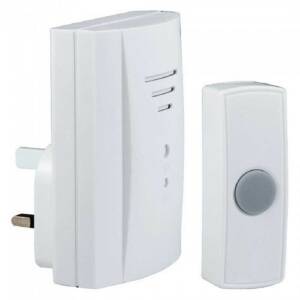Project Report For Electrical Door Chimes
Introduction
Project report for Electrical Door Chimes is as follows.
A doorbell is a signaling tool frequently located close to an entrance door to a structure. A bell within the building sounds when a visitor touches a button, alerting the occupant to the visitor’s presence. Modern doorbells typically have an electric switch, despite the fact that the first doorbells were mechanical and actuated by pulling a string.
The schematic and parts list for building a very basic wired doorbell alarm that you may install on your home’s door is included in this doorbell chime project. Everybody who is new to electronic design may get their hands on this project because it is so inexpensive and manageable.

A battery, a switch, and an electric motor are the only components of a basic electric circuit used in door chimes, which are mounted on sizable cardboard boxes. The motor started spinning when the switch was pressed by a caller, making a buzzing noise as it did so (a bit like the vibrating alert on a cellphone or pager).
The motor was heard when I was standing atop the box, although it was a fairly low buzzing sound. Real electric doorbells don’t differ all that much. They employ an electromagnet (a temporary magnet whose magnetism can be turned on and off instantaneously by electricity) instead of an electric motor and a cardboard box to create a more alluring sound, which can be produced by an electric bell, a buzzer, or chime bars hammered by a magnetic hammer.
Project Report Sample On
Electrical Door Chimes
Get Completely Custom Bankable Project Report
Product & Application of Electrical Door Chimes
- Wired doorbells : In most wired systems, a button on the outside next to the door, around the height of the doorknob, activates an internal signalling device (typically a chime, bell, or buzzer).
- Wireless doorbells : A battery-powered radio transmitter is incorporated into the doorbell button. When the button is pressed, the transmitter sends a radio signal to the reception device, which is plugged into an indoor wall socket.
- Musical and continuous power doorbells : Musical and continuous power doorbells serve as an attempt to bridge the gap between newer digital circuitry and older doorbell wiring schemes.
Manufacturing Process of Electrical Door Chimes
The four major components of radio-controlled chimes are: Radio waves are sent from the transmitter to the receiver. An antenna and circuit board within the doorbell receive signals from the transmitter and use the signals to activate motors inside the chimes. Motor(s): The transmitter uses radio waves to communicate a control signal to the receiver, which drives a motor to carry out a predetermined action. The music may be produced by the chimes’ motor. Usually a rechargeable battery pack, but occasionally just regular batteries, serve as the power supply.
Electronic circuits, electromechanical hardware components, mechanical assembly, and other subassembly parts must all be put together during the manufacturing process in accordance with the design. The electronics are then constructed on PCBs in accordance with the design, including the placement of ICs, transistors, diodes, resistors, capacitors, coils, and electromagnetic relays. The desired sound and music are tested on the built PCBs. A fiber/plastic casing houses the assembled electronics, electromechanical assembly, hardware such as connectors and switches, mechanical assembly, and light-emitting diodes.
Market Potential of Electrical Door Chimes
The market for doors was predicted to be worth about 135 billion USD in 2020. From 2023 to 2028, the market is anticipated to grow at a CAGR of 5.1%, reaching USD 182 billion by 2026.
Expenses

Product Cost Breakup

Reveneue Vs Expenses

Market Trend

A smart doorbell combines several software programs and hardware parts to ensure that homeowners are not required to answer the door until the visitor has been properly verified and identified. When the owner is not home, a smart doorbell can be used to notify them of the person at the door by using a live video stream and displaying a pre-programmed message. The rise in government and official initiatives is one of the key factors anticipated to fuel the growth of the smart doorbell market during the forecast period.
The market for smart doorbells is also predicted to develop as a result of the rise in threats to household and individual safety. However, it is also anticipated that the ultra-premium product evaluation of these doorbells will restrain the development of the smart doorbell market over the forecast period.
In the upcoming years, the market for smart doorbells may expand due to consumers’ increasing interest in smart locks, which have advantages like flexibility with high security, ease of installation, remote locking and unlocking, and speedy warnings to homeowners in the event of a theft. But because hackers can access the smart doorbell, there is a risk to home security, which could hinder the market’s expansion in the near future.

